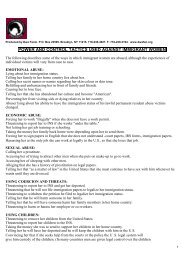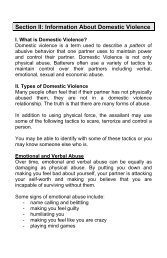Domestic Violence Counseling Manual - Hot Peach Pages
Domestic Violence Counseling Manual - Hot Peach Pages
Domestic Violence Counseling Manual - Hot Peach Pages
Create successful ePaper yourself
Turn your PDF publications into a flip-book with our unique Google optimized e-Paper software.
• Being self-righteous<br />
To be an effective listener, we must be humble and overcome our own arrogant belief that WE,<br />
the listener, are superior to whomever it is doing the talking. We must learn to accept thoughts,<br />
ideas, and concepts from others in order to best help them help themselves.<br />
• Personalizing<br />
It is often tempting to stop listening and start talking about ourselves. For example, “Oh yeah,<br />
that reminds me of the time…” or “You think that’s bad Listen to this!” The counselee is there<br />
to talk about her problems not to listen to yours.<br />
• Interrupting<br />
Do not interrupt a counselee when she is speaking. It is essential that she feel comfortable saying<br />
anything that comes to mind. If you are afraid you’ll forget something you want to say, write it<br />
down to save until she’s finished.<br />
STAGES OF A SESSION<br />
The following are the five main stages of a session. This is not to say that each counselee’s case should<br />
be resolved in one session. In fact, this is almost never advisable. You should take your time with each<br />
counselee, progressing at a slow and steady pace through their situation, and making sure they feel as<br />
much at ease as is possible. These stages are merely the skeleton of the progression of a counseling<br />
relationship. Stages 1, 4, and 5, however, are essential to every counseling session. Suggestions of<br />
phrases to use are in italics below the bulleted point when appropriate.<br />
1. Establishing Rapport<br />
• Extend a friendly, accepting greeting<br />
I’m glad you came to talk to me.<br />
• Recognize and respond to the counselee’s feelings<br />
What I hear you saying is… I’m picking up that you… Could it be that… Do you feel a<br />
little… Correct me if I’m wrong, but… Does it sound reasonable that… …is that what<br />
you mean … is that how you feel This is what I think I hear you saying… Let me see if I<br />
understand… That sounds frustrating. You seem torn, part of you wants to…and part of<br />
you wants to… I’m not sure if I understand, do you mean that…<br />
• Convey caring and concern through your words, tone of voice, facial expressions, and body<br />
language<br />
• Take your time easing into the problem to establish a solid base of trust and comfort<br />
• Ask open-ended questions<br />
How are you feeling about this now How were you feeling during the attack<br />
52-56

















